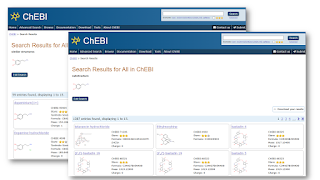- submitted: 2024-04-09 CASE Science, Center for the Advancement of Science Education, National Taiwan University
- accepted: 2024-06-13
- published: 2024-06-27 [中文] : 多變多巴胺第一部: ChEBI:18243
- DOIs: https://doi.org/10.5281/zenodo.12577272 ; https://doi.org/10.6084/m9.figshare.25794222
 |
| Fig 1: dopamine chemical families |
The most familiar KG is the information box displayed on the right side of Google search results. As a framework for understanding the entities and their relationships in the real world, the information that appears most often in the structured database - Wikipedia, and one of the wisdom behind this comes from semantic & ontological structures. If the ontology is placed in the context of popular science, it will help us quickly grasp the information, which is the saying that a picture is worth a thousand words. Because ontology has the advantage of visualizing data and combining images and textual knowledge trees to help readers move from familiar visual representations to abstract scientific understanding, we will try to use different ontologies to convey the complex stories of dopamine and bring readers to the concept of dopamine from the micro and macro perspectives respectively, and understand "her" properties, structure and basic knowledge more accurately.
Ontology: ChEBI
Within the realm of biomedical ontology, every knowledge unit—whether an entity or a node—embodies a distinct biological or chemical entity (such as genes, cells, diseases, drugs, and more), revealing essential attributes inherent to each compound. In the ontology, each connected edge (relation) describes the interaction or relationship between entities (such as "drugs treat diseases" or "cells up-regulate genes"). Therefore, using the standard vocabulary of "Chemical Entities of Biological Interest (ChEBI)" as a formal introduction to dopamine is quite consistent with our understanding of dopamine's molecular structure, role in biology, and common understanding among entities. Chemistry-specific relationships (such as the relationship types and family pedigrees depicted in Figure 2) take into account the need for both broad and in-depth understanding.
ChEBI is part of the Open Biomedical Ontology (OBO) of the Heidelberg-based European Molecular Biology Laboratory- European Bioinformatics Institute (EMBL-EBI) and focuses on integrating and describing data on "small" compounds. "Molecular entity" refers to any structurally or isotopically distinct atom, molecule, ion, ion pair, free radical, radical ion, complex, conformational isomer, etc. Recognizable as individually distinguishable entities, the molecular entities in question are either natural products or synthetic products designed to intervene in biological processes. ChEBI contains the relationship between an ontology classification and a specified molecular entity, or an entity class and its parents and/or children, usually called as a "parent-child relationship."
 |
| Figure 2: part knowledge structure of dopamine |
Dopamine in ChEBI Ontology
Dopamine (ChEBI: 18243) is defined in ChEBI as: Catechol in which the hydrogen at position 4 is substituted by a 2-aminoethyl group. 18243 is the "unique identification number" provided by ChEBI to each entity. In Figure 2, ChEBI: 18243 is a family of main group molecular entities (ChEBI: 33579), including one or more of any group in groups 1, 2, 13, 14, 15, 16, 17 and 18 of the periodic table of elements. A molecular entity of atoms. Dopamine, in this tree view, can be described as being a (is a) catecholamine (ChEBI: 33567), a monoamine molecular messenger (ChEBI: 25375), and an organic molecular entity (ChEBI: 50860).
However, dopamine also belongs to another branch of the family of chemical entities: phenols (ChEBI: 33853). As examined in Figure 3, it can be seen that dopamine is also a polyatomic entity (ChEBI: 36357), an organic aromatic compound (ChEBI: 33659), and a catechol (ChEBI: 33566). In Figure 1, it can also be seen that the conjugate base and conjugate acid of dopamine is dopamine (1+) (ChEBI: 59905), which is any mammalian "metabolite" produced during human metabolic reactions. In biology, the scientific role is related to neurotransmitter disorders. In subsequent articles, we will use other ontologies to further introduce it.
 |
| Figure 3: part knowledge structure of dopamine (graph view) |
In one of the main relationship categories of ChEBI "has role", the biological role of dopamine is described (ChEBI: 24432), including β-adrenergic agonists, E. coli metabolites, dopaminergic drugs, mimetic sympathogenic agents, mouse metabolites, and human metabolites. The application relationship (ChEBI: 33232) describes the intended use of the molecular entity or its parts by humans. Therefore, the application level of dopamine includes: cardiotonic drugs, β-adrenergic agonists, dopaminergic drugs and sympathomimetic agents, etc.
 |
| Figure 4: similar structures & has part relations within dopamine |
The latest version (2024/06/27) of ChEBI contains nearly 62,000 compounds and more than 190,000 "relationships". ChEBI has a wide range of applications, including the construction of biomedical knowledge graphs, its rich hierarchical structure and other relationship types, which can provide therapeutic assistance in identifying chemical entities in Alzheimer's disease and dementia literature. So the final question is, is it feasible to directly use ChEBI’s dopamine to communicate directly with the public?
Of course! As shown in Figure 5, PubChem, an open chemical database of the U.S. National Library of Medicine and the National Institutes of Health (NIH), uses ChEBI: 18243 as the source of information describing dopamine. In addition, when the news media acquaints us with dopamine’s role in pain, they cite ChEBI: 18243 as their source. ChEBI’s portrayal of dopamine reveals it as a chemical entity. But what narrative lies within its ‘cell family lineage’? (To be continued…)"
 |
| Fig 5: Using ChEBI:18243 for the reference source in PubChem |

